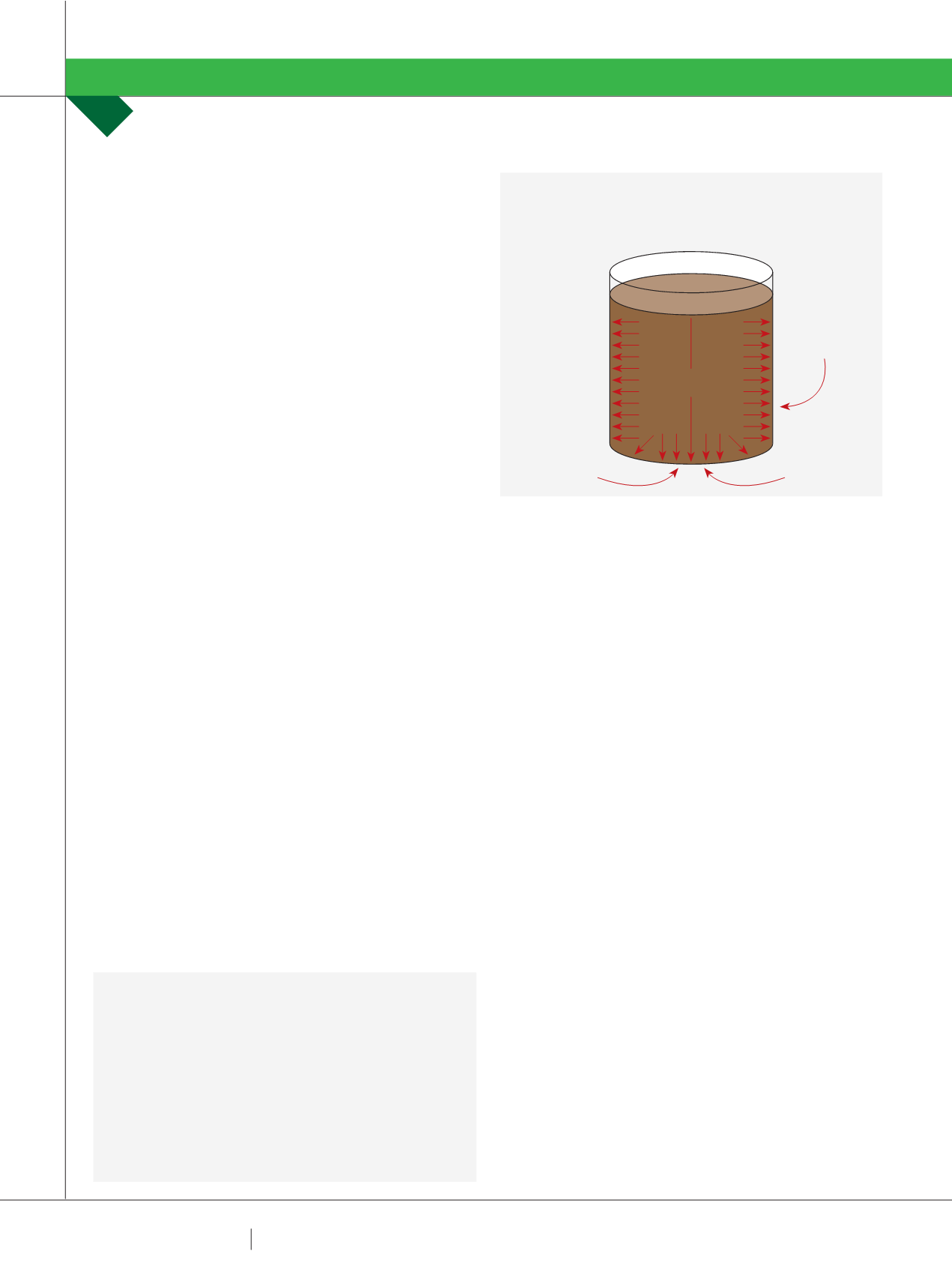

4 2
PLUMBING CONNECTION
AUTUMN 2016
Let’s get back to pressure…
If you place an empty coffee cup on the table, there is a
certain Pressure created between the bottom of the cup and
the table (Fig. 1). The magnitude of the Pressure depends on
the Weight of the cup and on the Area of the cup’s base. The
unit of Pressure is the Pascal (Pa). This is defined and the
number of Newton’s (Weight force) divided by the number
of square metres (Area). If you filled the coffee cup up with
coffee, the cup’s Weight (N) would increase, which means
the Pressure (Pa) between the cup’s base and the table
would also increase. Pressure is also measured in multiples
of Pascals like kilopascals (kPa) and Megapascals (MPa). For
fluid systems we usually measure Pressure in kPa, while for
construction materials (concrete and steel) we generally
measure pressure in MPa. Great, so what’s a coffee cup got
to do with fluid or pipe pressures? Let’s have a look…
Now that we have filled the cup with coffee, there are
also (static) Pressure forces acting inside the cup on the
walls and the base due to the Weight of the coffee (Fig. 1).
This Pressure increases as the depth increases due to the
Weight of the fluid (coffee) above. This is a fundamental
concept of Fluid Mechanics (for liquids): “The pressure at a
particular point below the surface is directly proportional to
the height of the liquid above the point.” This means that the
static Pressure in a liquid is caused by the Weight of the fluid
atoms (or molecules) above it.
Different fluids contain different molecules so they can
have different Weights and densities. Density is defined as
the weight of a fluid per unit volume. The unit of Density is
kilograms per cubic meter (kg/m3). The symbol for Density
is the Greek symbol,
ư
, (pronounced rho). Fresh water has
a density of approximately 1000kg/m3. Oil generally has a
density of around 900kg/m3 which is why oil floats on water.
Concrete has a density of around 2400kg/m3 which is why
it sinks in water. Salt water is slightly more dense than fresh
water at around
ư
= 1030kg/m3. This is why it is a bit easier
for us to swim in salt water than fresh water. You may have
seen photos of people floating around on the Dead Sea.
This is because it has a very high salt concentration with a
density of 1240kg/m3. Humans have an average density of
around 985kg/m3, so we can easily float on the Dead Sea.
HYDRAULIC CLASSROOM
DR TERRY LUCKE
The formula for the pressure at a particular point in a
liquid is shown in Equation 1:
P =
ư
gH …Eqn. 1
Where:
P = Pressure (Pa),
ư
= density (kg/m3),
g = acceleration due to gravity (9.8m/s2), and
H = height of fluid above point (m).
When dealing with fluids, we normally like the answer to
Eqn. 1 to be expressed in kPa. To do this, we simply divide
the answer by 1000. Here is an example to illustrate:
Example 1: What is the water pressure (kPa) acting on the
internal base of the tank shown in Figure 2?
Solution using Eqn 1:
P =
ư
gH = 1,000kg/m3 x 9.8m/s2 x 3.5m = 34,300Pa
However, the question asks for the Pressure in kPa, so we
simply divide this answer by 1000, i.e. 34,300/1000 = 34.3.
So the pressure acting on the base of the tank is 34.3kPa
(answer).
This process is always the same regardless of the liquid
being used. The main thing to remember is to make sure you
are using the correct Density for the liquid in question. For
example, if the fluid in example one was Oil (
ư
= 900kg/m3),
the base pressure would be approximately 30.9kPa (check
this for yourself!).
One of the most important concepts to understand
regarding static liquid pressures is that the pressure at a
certain point below the surface is only influenced by the
height (H) of the liquid above it. It makes absolutely no
difference what shape the fluid above or beside the point
is. For example, the water pressure acting on the inside
wall of a massive dam 50m below the surface is exactly
the same as the water pressure acting on the walls of a
Ø5mm diameter vertical tube, 50m below the water surface.
However, in this case the pressure would probably be too
great for the tube which may cause it to explode.
Many pipes are pressure rated to indicate the strength
of the pipe walls. A common classification system is the PN
(Nominal Pressure) rating system. It is pretty simple really;
a pipe with a PN4 classification can safely withstand an
internal fluid pressure of 400kPa. A PN6 pipe can withstand
600kPa and a PN12 pipe can withstand 1200kPa, etc…
FIGURE 1 – COFFEE CUP PRESSURE
Total Weight (N)
Pressure on Walls
and Base (Pa)
Contact Area of
Base (m
2
)
Pressure between
Cup and Table (Pa)
Pressure
Increase
















